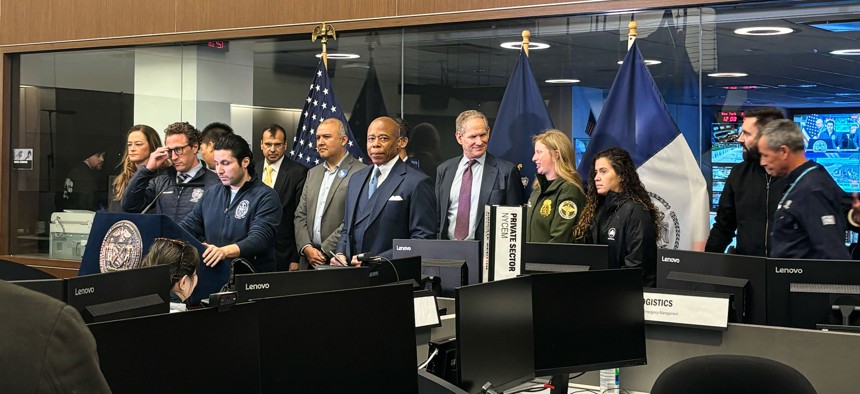News & Politics
No major earthquake damage reported in New York City
In a briefing alongside various agency heads, Mayor Eric Adams said New Yorkers should go about their business, but further assessments of infrastructure is ongoing.

Deputy Mayor for Communications Fabien Levy speaks to reporters about the earthquake as Mayor Eric Adams and other City Hall officials look on. Mia Hollie
New York City Mayor Eric Adams said “New Yorkers should go about their normal day” several hours after a 4.8 magnitude earthquake sent tremors across the five boroughs with impacts felt throughout the tristate area. It was the biggest quake to hit the city in 140 years.
“Earthquakes don’t happen everyday in New York City, so that can be extremely traumatic,” Adams said. “We are ready for the unexpected – this is New York City. We will respond accordingly.”
The earthquake, which lasted under a minute, rumbled buildings in New York City and sent tremors far across the Northeast. The United States Geological Survey identified Lebanon, New Jersey as its epicenter – roughly 50 miles west of New York City.
In separate press conferences Friday afternoon – one in Albany and the other at New York City Emergency Management headquarters – Gov. Kathy Hochul and Adams said that preliminary reports have not indicated major safety or infrastructure issues tied to the earthquake. Still, damage assessments are ongoing. The state is inspecting roads, bridges and other vulnerable areas. John F. Kennedy and Newark Airports are on full ground stops for the time being, although LaGuardia Airport remains fully operational. Kathryn Garcia, director of state operations, said it is likely because the airport was more recently renovated and meets higher standards.
“We are taking this extremely seriously,” Hochul said, adding that she immediately dispatched emergency management teams to begin assessing any damage. She warned of the possibility of aftershocks as well. “So these are wide scale possibilities,” Hochul said.
The U.S. Geological Survey currently estimates there is a 45% chance of an aftershock of at least magnitude 3 occurring during the next week. But there is only a 4% chance that an earthquake will occur in the next week that is even stronger than the Friday morning one.
New York City schools Chancellor David Banks said that all students in public schools were safe and that parents should not come and pick their children up early.
"All of our students across the school system are safe. All of our staff are safe. We have no reports of any structural damage to any of our school facilities, while many schools in fact felt some tremors from the earthquake,” Banks said.
Adams, who has previously garnered criticism over his administrations’ delayed responses to several emergencies, was quick to announce the press conference Friday morning – just several minutes after Hochul announced her own. While city officials began updating New Yorkers on X almost immediately after the quake hit at 10:23 a.m., many New Yorkers didn't receive an official emergency alert on their phones until 11:02 a.m. The first official text message from the city was sent out at 10:47 a.m. by way of the city’s Notify NYC system.
The state, however, was even slower. An emergency text alert from NYS Emergency Management did not hit phones until 12:05, nearly two hours after the earthquake hit and after the governor had already held a press briefing about her administration’s response.
New York City Emergency Management Commissioner Zach Iscol defended the roughly 20 minutes it took the city to issue an alert on NotifyNYC, arguing that officials needed time to confirm the rumbling was in fact an earthquake.
“There’s a lot of work we have to do to make sure we’re getting confirmation from USGS that this was actually an earthquake,” Iscol said. “Twenty minutes is very fast for a public notification.”
Only a handful of earthquakes have been felt in New York over the years. A 2.2 magnitude earthquake shook parts of New York and New Jersey last spring. More significantly, in 2011, a 5.8 magnitude earthquake in Virginia led to the evacuation of City Hall and office buildings in Midtown, Manhattan. According to The New York Times, the most significant quake hit New York City in 1884 when a 5.2 magnitude earthquake shook Coney Island.
This is a developing story and will be updated.
NEXT STORY: Who are the top NYPD officials posting controversial tweets?

